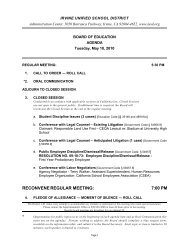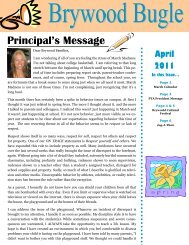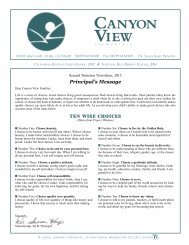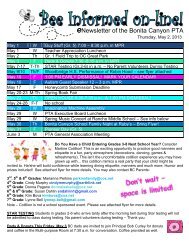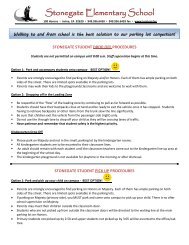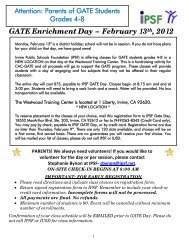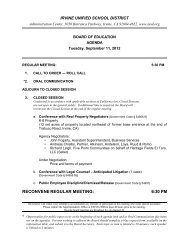1stTrim2012_Layout 1 - Irvine Unified School District
1stTrim2012_Layout 1 - Irvine Unified School District
1stTrim2012_Layout 1 - Irvine Unified School District
Create successful ePaper yourself
Turn your PDF publications into a flip-book with our unique Google optimized e-Paper software.
First Trimester 2012 • Canyon View Page 5<br />
What every family<br />
should know about head lice<br />
It Could Happen to Anyone...<br />
Head lice are just plain lousy. Not only do they get in your hair, literally, but they also make kids miss school,<br />
parents miss work and make everyone’s lives frustrating. By learning the facts about lice and a few simple tips<br />
for treating them, you can successfully combat this pesky, little invader.<br />
Facts about Lice:<br />
<br />
<br />
<br />
<br />
<br />
<br />
Head lice do not discriminate and can affect anyone: rich or poor, young or old, male or female.<br />
Head Lice don’t jump or hop or fly. They are mainly transmitted by head to head contact and by sharing<br />
objects such as combs, brushes, headbands, hats, hooded coats or sweaters with an infested person.<br />
Head lice don’t thrive on animals. They’re human parasites.<br />
Head lice don’t infest environments. They require human blood to live. However, lice can survive off the<br />
scalp several hours, and the eggs can last longer.<br />
Head lice aren’t seasonal. They can be contracted year-round in any climate.<br />
Heat from a hair dryer won’t kill head lice. Extreme temperatures (too hot for a person’s scalp) are needed<br />
to successfully kill them.<br />
Here are things you can do to keep head lice out of your hair:<br />
<br />
<br />
<br />
<br />
<br />
<br />
<br />
<br />
<br />
Watch for signs of head lice, such as frequent head scratching. Check the scalp regularly for lice and their<br />
eggs, called nits, using a good source of light. Lice are reddish brown insects about the size of a sesame<br />
seed. They may turn colors from white or gray to red or dark brown. Nits are grayish-white, always oval<br />
shaped, and are glued at an angle to the side of the hair shaft.<br />
Avoid confusing nits with hair debris like dandruff which is usually irregularly shaped and easy to remove,<br />
while nits are tear-shaped and difficult to dislodge.<br />
Only those infested should be treated. Treatments should not be used to prevent infestation.<br />
Consult a pharmacist or doctor before using a lice treatment on someone who is pregnant, breast feeding,<br />
has allergies, asthma, epilepsy, or other medical conditions or has lice or nits in the eyebrows or eyelashes.<br />
Remember that all lice-killing products are pesticides. Follow package directions carefully. Use the product<br />
over the sink, not in the tub or shower. Always keep eyes covered.<br />
Remove all nits. Separate hair in sections and remove all attached nits with a lice removal comb. Nits you<br />
can’t remove by combing can be removed by cutting them out with scissors or picking them out with your<br />
fingernails. Clean nails immediately if you use them to remove nits.<br />
Wash bedding, towels and recently worn clothing in hot water and dry in a hot dryer for at least 20 minutes.<br />
Combs and brushes should he soaked in hot water for 10 minutes. Vacuum all carpets, rugs, upholstered<br />
furniture mattresses, non-washable bedding, fuzzy toys and car interiors (seats and headrests) thoroughly.<br />
Notify your child’s school, camp, child-care provider, neighborhood parents and friends about the outbreak<br />
so they can be on the lookout.<br />
For more information, visit the following websites: www.headlice.org, www.liceout.com, or<br />
KidsHealth.org.




